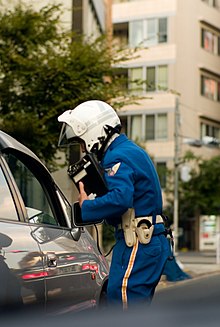
Traffic comprises pedestrians, vehicles, ridden or herded animals, trains, and other conveyances that use public ways (roads/sidewalks) for travel and transportation.
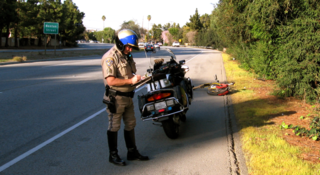
A highway patrol is a police unit, detail, or law enforcement agency created primarily for the purpose of overseeing and enforcing traffic safety compliance on roads and highways within a jurisdiction. They are also referred to in many countries as traffic police, although in other countries this term is more commonly used to refer to foot officers on point duty who control traffic at junctions.

The California Highway Patrol (CHP) is a state patrol of the U.S. state of California. The CHP has primary patrol jurisdiction over all California highways and roads and streets outside city limits, and can exercise law enforcement powers anywhere within the state. The California Highway Patrol can assist local and county agencies and can patrol major city streets along with local and county law enforcement, state and interstate highways, and is the primary law enforcement agency in rural parts of the state.

A police car is a ground vehicle used by police and law enforcement for transportation during patrols and responses to calls for service. A type of emergency vehicle, police cars are used by police officers to patrol a beat, quickly reach incident scenes, and transport and temporarily detain suspects, all while establishing a police presence and providing visible crime deterrence.
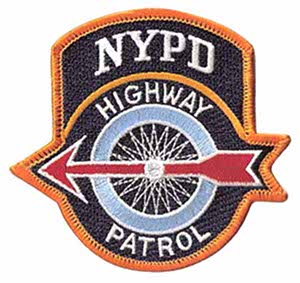
The Highway Patrol are specialized units part of the Highway District with the Transportation Bureau of the New York City Police Department. The Highway Patrol is primarily responsible for patrolling and maintaining traffic safety on limited-access highways within New York City. The Highway Patrol's other duties and roles include accident investigations, advanced driver and radar/laser speed enforcement training for NYPD officers, field sobriety testing at the various testing locations in each Patrol Borough, dignitary and parade escorts, hazardous material and truck traffic enforcement, anti-drag racing programs, and anti-terrorist checkpoints at key bridges and intersections in the city.
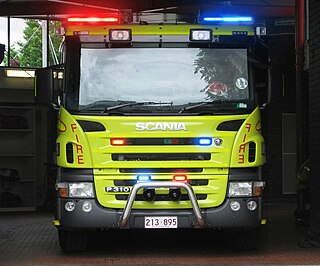
Emergency vehicle lighting, also known as simply emergency lighting or emergency lights, is a type of vehicle lighting used to visually announce a vehicle's presence to other road users. A sub-type of emergency vehicle equipment, emergency vehicle lighting is generally used by emergency vehicles and other authorized vehicles in a variety of colors.

The Michigan State Police (MSP) is the state police agency for the U.S. state of Michigan. The MSP is a full-service law enforcement agency, with its sworn members having full police powers statewide.
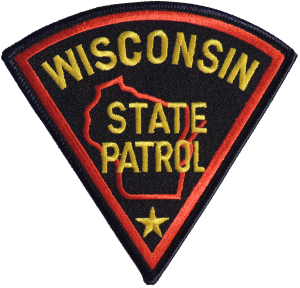
The Wisconsin State Patrol is the state patrol for the state of Wisconsin and is a division of the Wisconsin Department of Transportation. The Wisconsin State Patrol enforces traffic and criminal laws, oversees the motor carrier safety and weight facilities (SWEFs), inspects and regulates motor carriers, school buses and ambulances, and assists local law enforcement agencies with traffic safety, civil disturbances and disasters.
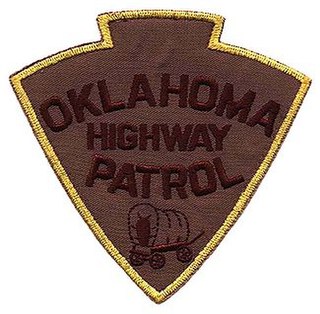
The Oklahoma Highway Patrol (OHP) is a major state law enforcement agency of the government of Oklahoma. A division of the Oklahoma Department of Public Safety, the OHP has traffic enforcement jurisdiction throughout the state. OHP was legislatively created on July 1, 1937, due to the growing problem of motor vehicle collisions, the expansion of highway systems, and the increase in criminal activities.

The Colorado State Patrol(CSP) (originally known as the Colorado State Highway Courtesy Patrol), based in Lakewood, Colorado, is a division of the Colorado Department of Public Safety, and is one of the official state patrol agencies of Colorado, along with the Colorado Bureau of Investigation (CBI), Colorado Division of Criminal Justice (DCJ), Colorado Division of Fire Prevention & Control (DFPC), and Colorado Division of Homeland Security and Emergency Management (DHSEM). Additionally, the Executive Director's Office supports operations of the five divisions and houses the Colorado School Safety Resource Center (CSSRC) and Colorado Integrated Criminal Justice Information Systems (CJIS). The CSP primarily enforces traffic laws on interstates and state highways and guards the state capitol and the Governor of Colorado.

The Texas Highway Patrol is a division of the Texas Department of Public Safety and is the largest state-level law enforcement agency in the U.S. state of Texas. The patrol's primary duties are enforcement of state traffic laws and commercial vehicle regulation, but it is a fully empowered police agency with authority to enforce criminal law anywhere in the state. Highway patrol troopers are also responsible for patrolling the state Capitol Complex in Austin and providing security to the governor. The current Chief is Lieutenant Colonel Dwight Mathis.

The Ohio State Highway Patrol is a division of the Ohio Department of Public Safety and has the primary responsibility of traffic enforcement in the U.S. state of Ohio.

The Maryland Transportation Authority Police is the eighth-largest law enforcement agency in the U.S. state of Maryland and is charged with providing law enforcement services on Maryland Transportation Authority highways and facilities throughout the Maryland, in addition to contractual services that are provided at Baltimore–Washington International Thurgood Marshall Airport, and the Port of Baltimore.
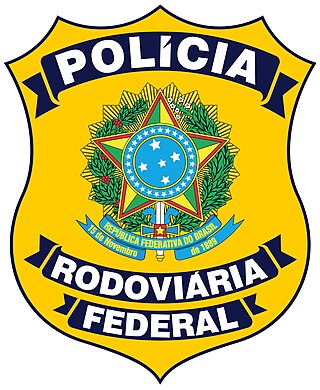
The Brazilian Federal Highway Police is a federal highway patrol, subordinate to the Ministry of Justice, whose main function is fighting crime on Brazilian federal roads and highways, as well as monitoring and supervising vehicular traffic, although it has also taken on duties that go beyond its original authority, such as action within Brazilian cities and forests in conjunction with other public safety agencies.

In the United States, the state police is a police body unique to each U.S. state, having statewide authority to conduct law enforcement activities and criminal investigations. In general, state police officers or highway patrol officers, known as state troopers, perform functions that do not fall within the jurisdiction of a county’s sheriff, such as enforcing traffic laws on state highways and interstates, overseeing security of state capitol complexes, protecting governors, training new officers for local police forces too small to operate an academy and providing technological and scientific services. They also support local police and help to coordinate multi-jurisdictional task force activity in serious or complicated cases in states that grant full police powers statewide.

Police transport refers to any form of transportation used by police in their duties. These primarily include methods for patrol and prisoner transport.

Arkansas Highway Police is a state police division of the Arkansas Department of Transportation. The Arkansas Highway Police is responsible for enforcing motor vehicle laws, traffic laws, and commercial vehicle enforcement. It is the second-largest state law enforcement agency in Arkansas after the Arkansas State Police. It was founded in 1929 and is the oldest law enforcement agency in Arkansas.

Terminology related to road transport—the transport of passengers or goods on paved routes between places—is diverse, with variation between dialects of English. There may also be regional differences within a single country, and some terms differ based on the side of the road traffic drives on. This glossary is an alphabetical listing of road transport terms.
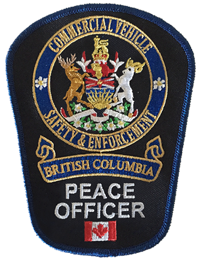
British Columbia Commercial Vehicle Safety & Enforcement is a provincial law enforcement agency that is responsible for the compliance and enforcement of the commercial transport sector, protection of the environment and transportation infrastructure of British Columbia, increasing road safety and protecting the motoring public.
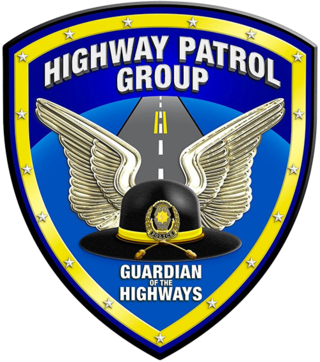
The Highway Patrol Group is a police unit under the Philippine National Police (PNP) who supervises traffic-related crimes and its management.






